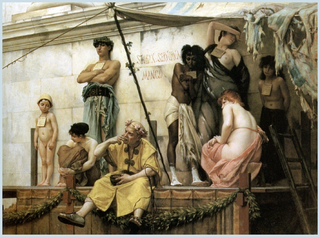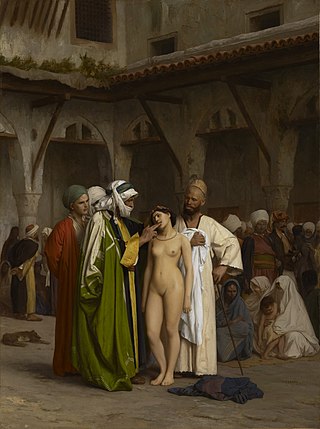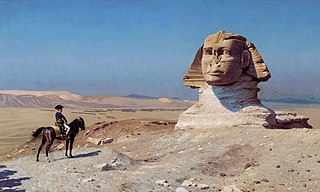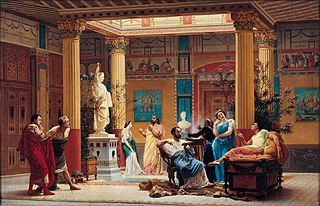A slave market is a place where slaves are bought and sold.
Slave market may also refer to:
A slave market is a place where slaves are bought and sold.
Slave market may also refer to:

Jean-Léon Gérôme was a French painter and sculptor in the style now known as academicism. His paintings were so widely reproduced that he was "arguably the world's most famous living artist by 1880." The range of his oeuvre included historical painting, Greek mythology, Orientalism, portraits, and other subjects, bringing the academic painting tradition to an artistic climax. He is considered one of the most important painters from this academic period. He was also a teacher with a long list of students.

Phryne was an ancient Greek hetaira (courtesan). From Thespiae in Boeotia, she was active in Athens, where she became one of the wealthiest women in Greece. She is best known for her trial for impiety, where she was defended by the orator Hypereides. According to legend, she was acquitted after baring her breasts to the jury, though the historical accuracy of this episode is doubtful. She also modeled for the artists Apelles and Praxiteles, and the Aphrodite of Knidos was based on her. Largely ignored during the renaissance, artistic interest in Phryne began to grow from the end of the eighteenth century; her trial was famously depicted by Jean-Léon Gérôme in the 1861 painting Phryne Before the Areopagus.

Pollice verso or verso pollice is a Latin phrase, meaning "with a turned thumb", that is used in the context of gladiatorial combat. It refers to a hand gesture or thumb signal used by Ancient Roman crowds to pass judgment on a defeated gladiator.

Osman Hamdi Bey was an Ottoman administrator, intellectual, art expert and also a prominent and pioneering painter. He was the Ottoman Empire's first modern archaeologist, and is regarded as the founding father of both archaeology and the museum curator's professions in Turkey. He was the founder of Istanbul Archaeology Museums and of the Istanbul Academy of Fine Arts known today as the Mimar Sinan Fine Arts University. He was also the first mayor of Kadıköy.

Gustave Clarence Rodolphe Boulanger was a French figurative painter and academic artist and teacher known for his Classical and Orientalist subjects.
Crucifixion is an ancient method of execution.

The Slave Market is a painting first exhibited at the Paris Salon of 1886 by the French artist Gustave Boulanger, who specialized in classical and Orientalist genre scenes. Its title in the Salon catalogue was Un Maquignon d’esclaves à Rome, but as early as 1888 it was called Vente d’esclaves in the French press, and in English it has become known as The Slave Market. It is sometimes compared to or confused with various paintings of slave markets in the Arab world and the ancient world by Boulanger's friend and fellow painter Jean-Léon Gérôme.

Pollice Verso is an 1872 painting by French artist Jean-Léon Gérôme, featuring the eponymous Roman gesture directed to the winning gladiator.
The Haggin Museum is an art museum and local history museum in Stockton, San Joaquin County, California, located in the city's Victory Park. The museum opened in 1931. Its art collection includes works by European painters Jean Béraud, Rosa Bonheur, William-Adolphe Bouguereau, Jean-Léon Gérôme, and Pierre-Auguste Renoir, landscapes by French artists of the Barbizon school, and sculptures by René de Saint-Marceaux, Alfred Barye, and Auguste Rodin. The museum also features a number of works by Hudson River School and California landscape painters, including the largest collection of Albert Bierstadt works in the region, and in 2017 dedicated a gallery to display the largest public collection of original artworks by J. C. Leyendecker.

The Snake Charmer is an oil-on-canvas Orientalist painting by French artist Jean-Léon Gérôme produced around 1879. After it was used on the cover of Edward Said's book Orientalism in 1978, the work "attained a level of notoriety matched by few Orientalist paintings," as it became a lightning-rod for criticism of Orientalism in general and Orientalist painting in particular, although Said himself does not mention the painting in his book. It is in the collection of the Sterling and Francine Clark Art Institute, which also owns another controversial Gérôme painting, The Slave Market.

Cleopatra and Caesar, also known as Cleopatra Before Caesar, is an oil-on-canvas painting by the French Academic artist Jean-Léon Gérôme, completed in 1866. The work was originally commissioned by the French courtesan La Païva, but she was unhappy with the finished painting and returned it to Gérôme. It was exhibited at the Salon of 1866 and the Royal Academy of Arts in 1871.
La Vérité may refer to:
Pygmalion and Galatea are two characters from Greco-Roman mythology.

The Slave Market is an 1866 painting by the French artist Jean-Léon Gérôme. It depicts a Middle Eastern or North African setting where a man inspects the teeth of a nude, female Caucasian slave in the context of the Barbary slave trade.

Bonaparte Before the Sphinx is an 1886 painting by the French artist Jean-Léon Gérôme. It is also known as Oedipus (Œdipe). It depicts Napoleon Bonaparte during his Egyptian campaign, positioned on horseback in front of the Great Sphinx of Giza, with his army in the background.
Bathsheba, in the Hebrew Bible, was the wife of Uriah the Hittite and later of David.

Tanagra is a polychromic marble sculpture created by French artist Jean-Léon Gérôme (1824–1904) as a personification of the "spirit of Tanagra," his own mythic invention tied to the Tanagra figurines from the village of that name in ancient Greece. The sculpture was first shown at the Paris Salon of 1890. Gérôme subsequently created smaller, gilded bronze versions of Tanagra; several versions of the "Hoop Dancer" figurine held by Tanagra; two paintings of an imaginary ancient Tanagra workshop; and two self-portraits of himself sculpting Tanagra from a living model in his Paris atelier. These sculptures and paintings comprise a complex, self-referential artistic program in which one of the most celebrated artists of his generation explored reception of Classical antiquity, creative inspiration, doppelgängers, and female beauty.

Slave Market in Ancient Rome is a painting of about 1884 by French artist Jean-Léon Gérôme, who was known for combining classical, romantic, and realistic elements.

Garafilia Mohalbi(y) (Greek: Γαριφαλιά Μιχάλβεη; 1817 – March 17, 1830) was a Greek slave that was rescued by an American merchant and sent to live with his family in Boston, Massachusetts. Born to a prominent family on the island of Psara, her parents were killed in 1824 during the Destruction of Psara by the Turks. She arrived in Boston around the same period Samuel Gridley Howe brought John Celivergos Zachos and Christophorus Plato Castanis and other Greek refuges. She died aged thirteen. After her death, she became a popular celebrity in the media and among abolitionists.

Répétition du "Joueur de flûte" et de "La femme de Diomède" chez le prince Napoléon is a painting by French artist Gustave Boulanger. The painting's full title as given in the catalogue for the Paris Salon of 1861 is Répétition du "Joueur de flûte" et de "la Femme de Diomède," chez S.A.I. le prince Napoléon, dans l’atrium de sa maison, avenue Montaigne.